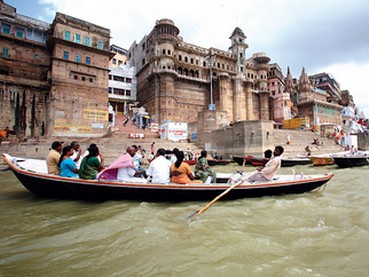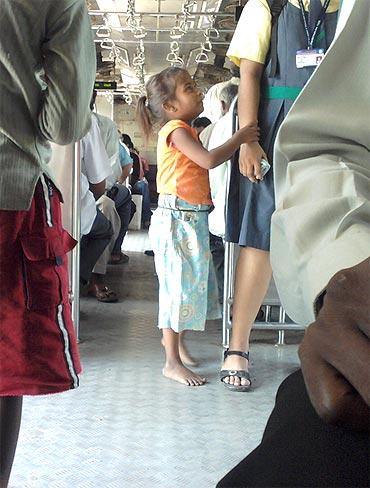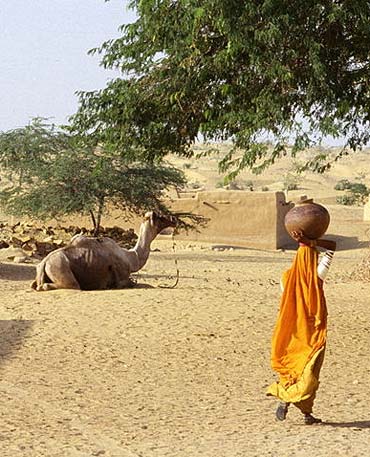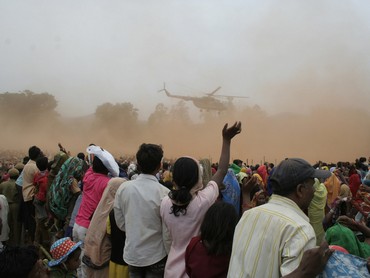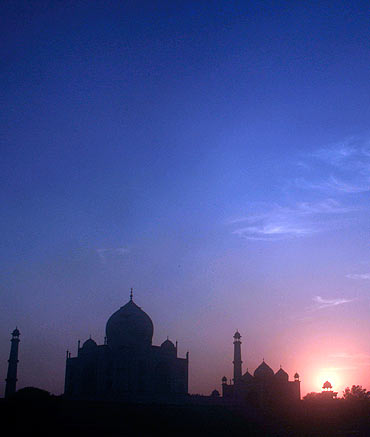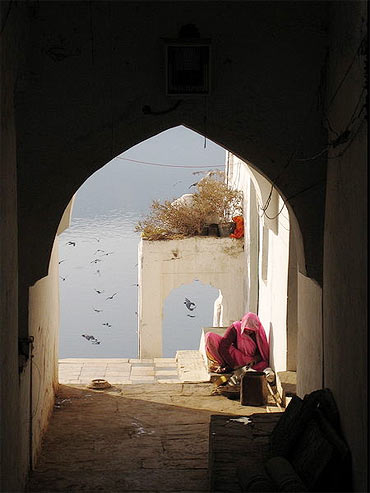 | « Back to article | Print this article |
'India has helped me to search deeper within myself'
Arthur J Pais charts out the fascinating journey of 14 young American Indians who went looking for the Real India but found their real self instead! Over the coming days we will publish individual stories of these young girls and boys. Do read on...
Growing up in Ocean County, California, Priyanka Venkatesh decided over a decade ago that she could be a model American but also have Indian heritage ingrained in her.
'In California, I decided I didn't want to be an American Born Confused Desi anymore,' she wrote in an essay. 'First, I delved into learning Kannada, a South Indian language.
Through books, I was able to learn the grammar and structure. Then, I developed fluency by speaking with my parents and other people in our cultural community every chance I got.'
Venkatesh, a human biology and violin performance student at Stanford University, who has been learning Carnatic and Western-style violin for more than 15 years, recently received yet another opportunity to know India better.
She was among 14 young American students and graduates to spend over two weeks in Rajasthan as part of the Bharat Yatra annual summer camps organized by New York Life. The all-expenses paid sojourn, now in its eighth year, chooses the yatris following an essay competition.
Venkatesh, who performed with the Pacific Symphony Youth Orchestra, has enjoyed going to India and meeting her relatives from whom she gains insights into Hinduism and Indian culture at large.
'No amount of reading is a match for the real-time India experience'
About a recent visit to India, Priya Venkatesh told the Ocean County newspaper: 'We were able to have intelligent discussions (in Kannada and Hindi) about everything from Indian music and dance to Indian politics and the flourishing economy. I have gone from cultural ignorance to cultural vitality in just a few years.'
But the Rajasthan sojourn was far more intense than her previous visits.
"Before being selected as a yatri, I had read much regarding how India may rise to greatness once again," she muses. "But that no match for the real-time experience I gained. Whether we were visiting a school and dancing with enthusiastic children during lunch break, or talking with Jaipur Foot and Limb founder D R Mehta about the ways his organization has given new life to so many Indians, I was filled with hope and desire to give back."
The Yatra took place July 24 to August 8. The students visited Bikaner, Mandawa, Jodhpur, Ajmer and Jaipur. Apart from visiting tourist attractions like forts, temples, mosques, forest reserves, they also visited old-age homes, hospitals, leprosy clinics and schools.
New York Life executives -- Ashwin K Verma, corporate vice president, and chief marketing officer, cultural market and Srinivas R Ranga, assistant VP, market management -- led the team.
"The aim was to show the yatris much more than the traditional or tourist part of a state in India," says Verma. "They get to see and experience the real India. The Yatra helps them understand the challenges faced by India and motivates them to give back to the country of their heritage."
The annual visits are documented and the documentary film is sent to hundreds of people who have been involved in the current and previous Yatras. This year's documentary is called The Eternal Spirit of India.
'I got to see India like I'd never seen before'
The places the yatris visited included the Bhagwan Mahaveer Viklang Sahayata Samiti (Jaipur Foot and Limb); Mathura Das Mathur Hospital, Jodhpur; Asha Ka Jharna School for physically challenged children, Mandwa; Nimba Nimandi Leper Ashram, Jodhpur; Anubandh, home for the aged, Jodhpur; and Badhir Vidhyalaya, school for the hearing and speaking impaired, Ajmer.
There was an almost unanimous consent among the 2010 yatris that the most inspiring person they came to know is DR Mehta, who following a car accident in which he broke a leg, came to realise the plight of the poor people in securing prosthetic limbs. Many yatris said they were impressed with the dignified way the poor are treated at the clinic.
A graduate of arts and law from Rajasthan University, Mehta studied at the Royal Institute of Public Administration, London, and the MIT Sloan School of Management, as well.
He joined the Indian Administrative Service in 1961 and held top positions in the Rajasthan and the federal governments. The yatris said his desire to give back to the community in an efficient and scientific way was hugely inspiring.
The Jaipur Foot was created in the late 1960s -- and the Bhagwan Mohair Viklang Sewa Samiti opened in 1975, helping thousands of poor people who come from across India.
Each year, a new state is chosen for the Yatra.
"We have thought of sending the yatris to some of the little known states in the country," Verma says. "But given the (poor) infrastructure in these states and the fact that the yatris spend about two weeks, we did not pursue the idea."
Many yatris have continued to be associated with NGOs in India, and four started an organisation called Dil Se to launch rural medical camps and youth outreach programs in Uttarkhand.
"I lived in Mumbai for many years before coming to America," Verma continues. "I got to see India like I had never seen before only because of Bharat Yatra."
Verma who plans to retire next year says the Yatras inspired him so much that he is planning to start a retirement home for the poor who have no families.
"Americans might believe in individualism but India's beauty is in preserving its cultures and morals," says Sadaf Omar, another 2010 participant, a senior at Lehman College in New York.
'People in India don't need to change'
Sadaf Omar, who plans to study law and policy adds: "I used to think that India's biggest problem was that people there did not want to change. Now I feel, people there don't need to change. Their culture, morals and beliefs are amazing."
Esha Khurana, a medical student at Northwestern declares: "By experiencing India, we experienced all of humanity, its unswerving strengths, its crippled weaknesses, its unparalleled beauty, condensed, clarified and dilated."
Nilay Suresh Shah, who is also studying at Northwestern, echoes her sentiments. "Though it was only for two weeks, it is intricately tied to my jeevan yatra [life journey] because of the indelible impression it has left on my worldview," he said.
Aria Srinivasan, Monika Mehta and Jasdeep Cheema too learned many life lessons.
"I was pushed beyond my comfort zone by meeting so many new people, adapting to new situations, and thinking of problems I would have ignored," reflects Srinivasan, a sophomore at Drexel majoring in business and Political science.
"We were forced to critically think and grow our appreciation for beauty of all sorts."
For some, who migrated from India with their parents when they were young, the Yatra was an eye-opener.
"For once we were seeing an India usually our parents or relatives would not have had the time to show to us," says Monika Pathak. A recent graduate with a degree in applied mathematics, she plans to pursue a career in actuary. She was 11 when she came to America from Uttar Pradesh.
"We saw some fabulous sights including palaces but what was also important was that we got many opportunities to witness how people are coping despite hardships, how things can be improved, and how things are being improved."
'I thought if she can do it, I too could do something like that'
Monika Pathak grew up in a village in Uttar Pradesh but her parents sent her to a good city school.
Among her most memorable encounters was an unsung heroine who was helping many elderly people abandoned by their children live in a hospice. The woman was in her 50s and has been doing it for several years. Many of the older people were depressed and hurt the way they were treated by their own children, Pathak could see, but on the other hand, they could live with dignity and with hope at the shelter.
"I thought if she can do it, I too could do something like that," Pathak adds.
She could also see how free enterprise worked. "There were not only more cars on the road, they were good cars," she continues. "I could see there was far less bureaucracy and many people had started not to rely on the government."
Many, including Pathak, found the Asha Ka Jharna schools for the mentally retarded and hearing impaired children model institutions.
Some have dreams of going back to these schools and staying back for several months as volunteers.
The Mandawa-based AKJ schools are voluntary non-profit organizations working for the disabled for over 13 years. Run in rural Rajasthan, they offer special education, therapy, guidance and counseling to over 175 children and their families. It has several income-generation programs including a dairy project for low-income women.
"I was surprised to see how clean and professional the school I visited was," Pathak remembers. "The teachers were very dedicated."
The schools had not only make extra efforts to persuade the parents to send the children for studies but also ensure they were picked up from their homes and dropped back. Nutritious meals were supplied, there was also medical help and there were lessons in hygiene too.
For Pathak and others this was a sign of real progress, of India shining and winning, they say. Jasdeep Cheema, who is majoring in biochemistry and chemical engineering at Seton Hall University, New Jersey, says the India trip "has helped me to search deeper within myself, evaluate my motivations and my faith and how I can help in my own way to offer help and hope."
Her previous visits to India were vastly different.
'You feel challenged again and again'
"We went as tourists," Jasdeep Cheema says in a rueful voice. "Beggars came up to us, I saw servants being ill treated in many families including our own but somehow our eyes were not opened. It bothered me but not enough."
But being away from parents, family members and friends, she was her own person on this trip. "There were not the kind of distractions you have when you go on a vacation or family visit," she adds.
In many places, she found incredible amount of dedication -- teachers working even though they had not been paid for eight to 10 months in one instance. In one hospital, she discovered, seven doctors looked after 200 patients. She also suspected that there are similar situations, or even worse, across India.
"And yet I came across doctors working under great stress with hardly any resources and yet doing great service," she continues. "I was shocked seeing the terrible situation in hospitals and yet there was immense dedication in some doctors. They don't understand how great their services are."
After the Rajasthan sojourn, she stayed back for a few days helping the renowned Pingalwara hospital near Amritsar.
She says she was inspired by the Rajasthan visit to volunteer her time. She Googled for a good NGO and discovered that though Pingalwara meant 'a home for the handicapped,' the institution helped the crippled, the insane and the terminally sick. It also was a rescue-home for social outcasts including the maimed.
She is planning to go back in summer.
"You feel challenged again and again because of the Yatra," she says.
She had known for a long, as a volunteer, that there are many institutions needing help in America and any other country. But on this trip she had an opportunity to learn of compelling opportunities in India for Indian Americans with medical and social entrepreneurial skills.
